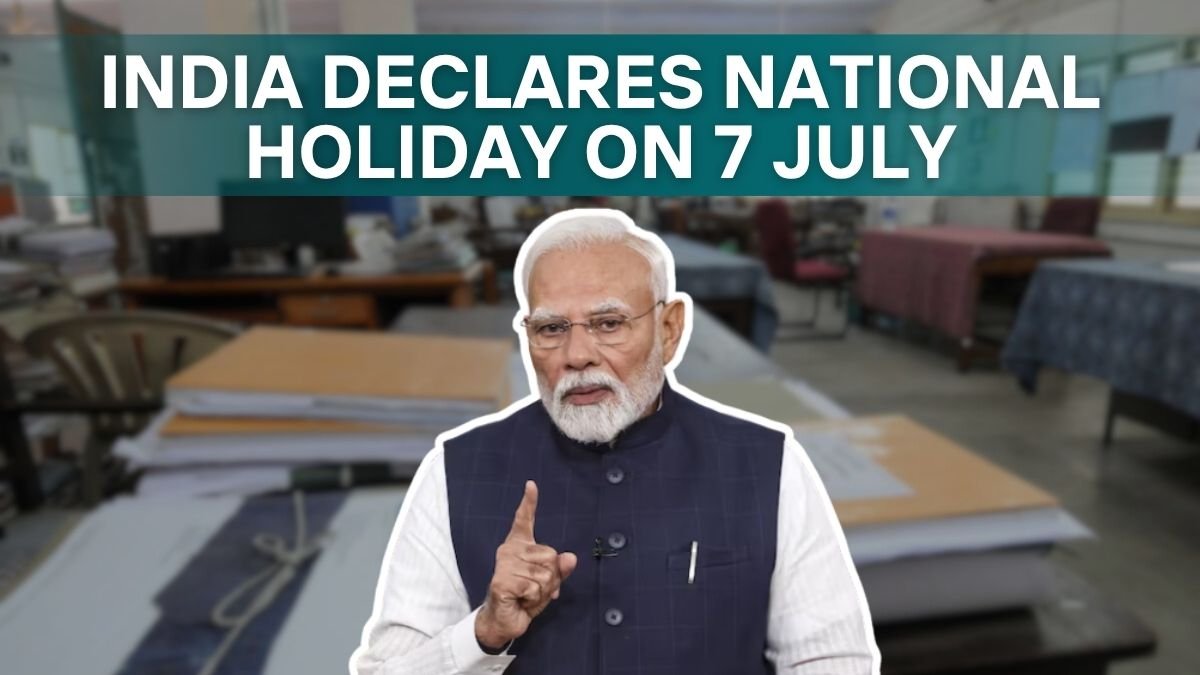India Declares National Holiday on 7 July! Here’s Why Everyone’s Celebrating
The Government of India has declared July 7 an unprecedented national holiday, and the aim is not only to honor India’s cultural heritage but also to celebrate the diversity and unity of the country wholeheartedly. This special day will be celebrated as a grand celebration at the national level, with citizens from every corner of India participating. From the bustling streets of Mumbai to the serene valleys of Kerala, every state and every city will be decked out with colorful decorations, music, dance and traditional arts. This is the moment when India becomes not just a country but a living and throbbing culture.
Celebrating Diversity in Unity
The July 7 holiday is not just a day of rest; it is a day to celebrate India’s most fundamental identity—“Unity “in Diversity.” This special holiday has been declared to remind the countrymen that India, which is home to hundreds of languages, religions and traditions, is still tied together by the strong bond of unity. On this day, the government will organize cultural fairs, exhibitions, and parades, where every state will present its unique culture and traditions. This will present India to the world as a country that maintains harmony and cordiality even in its diversity.
Cultural events across the country: Every street will become a stage for celebration.
The government has prepared plans on a large scale to make this day special. Exhibitions of traditional handicrafts, food, and folk arts will be organized in major metros of the country. Along with this, grand parades will be organized in Delhi and other cities, in which the pride of the Indian Army and cultural diversity will be seen together.
Famous artists will perform in musical programs organized in different states, which will be an attempt to connect people through music. There will be a special display of fireworks at night, which will become a symbol of hope and enthusiasm. Apart from this, shared feasts will be organized in every community, where people will eat together and try to understand each other’s traditions.
Local businesses will get a new lease on life.
A positive impact of this festival will also be seen on India’s local economy. In particular, the hotel, restaurant, tourism and handicraft sectors will benefit greatly from this festival. A large number of tourists from India and abroad will visit India, increasing the demand for hotels and travel services.
Local artisans and vendors will be able to take full advantage of this opportunity, as activities like fairs in markets, sales of local products, and exhibitions will increase their earnings. This will not only support them financially but will also get a larger audience for their crafts.
Impact on key sectors and preparations
| Sector | Expected Impact | Strategy for Preparation |
|---|---|---|
| Hospitality | Increase in bookings and guest traffic | Enhance services and offer special packages |
| Tourism | Rise in domestic and international tourists | Promote tourism packages and attractions |
| Retail | Sharp increase in sales | Launch festive promotions and discount plans |
| Transport | Spike in travel bookings | Introduce additional services and new plans |
| Entertainment | High participation in events | Organize special shows and performances |
| Food & Catering | Rise in restaurant and catering orders | Introduce special menus and offers |
| Art & Craft | Increased demand for traditional items | Organize exhibitions and workshops |
| Telecommunications | Higher service usage | Offer special data and talk-time packs |
Preparations are in full swing across the country.
The central and state governments are working together to make this festival a success. Security arrangements are being tightened to avoid any kind of disturbance. Traffic control, increased public transport, and decoration of public places are all part of the plans.
A dedicated organizing committee has been formed in each city, which will control the activities at the local level. At the same time, through public awareness campaigns, people are being informed about how to participate in these events and follow safety rules. Media coverage will also work to spread the grandeur of this day to the country and the world.
Special presentation of every state
Every state of India will get a chance to present its unique heritage in this festival. Below are the plans of some major states:
| State | Main Event | Unique Feature |
|---|---|---|
| Maharashtra | Cultural Parade | Lavani Dance Performances |
| Rajasthan | Folk Music Festival | Traditional Puppet Shows |
| Kerala | Boat Race | Onam Festivities |
| Tamil Nadu | Classical Music Concert | Bharatanatyam Dance |
| West Bengal | Pandal Hopping | Durga Puja Art Installations |
| Punjab | Bhangra Dance Competition | Punjabi Food Stalls |
| Gujarat | Garba Night | Colorful Traditional Costumes |
| Uttar Pradesh | Ram Leela Performance | Traditional Storytelling |
Public participation and local involvement
This day is being seen not only as a government program but as a public movement. Local programs are being planned by schools, colleges, community centers and NGOs. Competitions, cultural programs and traditional workshops are being organized for students.
Social media campaigns are also running fast, where people are sharing their experiences and glimpses of traditional costumes and cuisine. Through volunteer programs, youth are participating in the event and various heritage walks are connecting people to their historical sites.
Economic and social benefits
The impact of this national holiday will be seen not only at cultural but also at both economic and social levels. Tourism, hotels, handicraft and other MSME sectors will witness positive developments such as increased revenue, new employment opportunities, and a boom in local trade.
On a social level, the event will strengthen community spirit, deepen people-to-people contacts, and promote a sense of social harmony in the country. Cultural exchange, nurturing of creativity, and a sense of patriotism are the soul of these events.
Concern for the environment too
Despite such a big event, the government and the organizers are ensuring that the environmental balance is not disturbed. Keeping sustainable development in mind, steps like eco-friendly decoration, waste management, and promotion of public transport are being taken.
- Waste management: recycling and waste reduction
- Eco-friendly decoration: use of biodegradable materials
- Promotion of public transport: use of metros and buses instead of private vehicles
- Carbon offset: planting trees and supporting green projects
- Awareness campaign: public awareness about environmental protection
FAQs
Q1. Why is 7 July declared a public holiday in India?
A1. The government declared 7 July as a national holiday to celebrate India’s cultural unity and diversity.
Q2. Will schools and offices remain closed on 7 July?
A2. Yes, all schools, colleges, and government offices will remain closed nationwide.
Q3. What events are planned for the 7 July celebration?
A3. Cultural parades, music concerts, community feasts, fireworks, and exhibitions will be held across India.
Q4. How will the holiday impact tourism and local businesses?
A4. The holiday is expected to boost tourism, increase hotel bookings, and benefit local artisans and retailers.
Q5. Are any security or traffic measures being taken?
A5. Yes, enhanced police presence, special traffic plans, and public awareness campaigns are in place for safety.
Final Verdict
This national holiday of 7th July is a unique and historic step in the history of India. This day is not just a day of celebration but also a day of worship. It is not just an occasion to celebrate India’s values, diversity and unity. It not only revitalizes the culture but also strengthens the country’s economy, social cohesion and global identity.
On this day, India is all set to show the world how a country full of thousands of traditions and languages can stand together and celebrate one day—through dance, music, food and brotherhood.


